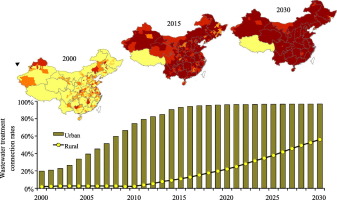Environment International ( IF 10.3 ) Pub Date : 2018-03-22 , DOI: 10.1016/j.envint.2018.03.013 Ying Zhu , Oliver R. Price , John Kilgallon , Yi Qi , Shu Tao , Kevin C. Jones , Andrew J. Sweetman

|
Water pollution are among the most critical problems in China and emerging contaminants in surface water have attracted rising attentions in recent years. There is great interest in China's future environmental quality as the national government has committed to a major action plan to improve surface water quality. This study presents methodologies to rank the importance of socioeconomic and environmental drivers to the chemical concentration in surface water during 2000–2030. A case study is conducted on triclosan, a home and personal care product (HPCP) ingredient. Different economic and discharge flow scenarios are considered. Urbanization and wastewater treatment connection rates in rural and urban areas are collected or projected for 2000–2030 for counties across China. The estimated usage increases from ca. 86 to 340 t. However, emissions decreases from 76 to 52 t during 2000–2030 under a modelled Organisation for Economic Co-operation (OECD) economic scenario because of the urbanization, migration and development of wastewater treatment plants/facilities (WWTPs). The estimated national median concentration of triclosan ranges 1.5–8.2 ng/L during 2000–2030 for different scenarios. It peaks in 2009 under the OECD and three of the Intergovernmental Panel on Climate Change (IPCC), A2, B1 and B2 economic scenarios, but in 2025 under A1 economic scenario. Population distribution and surface water discharge flow rates are ranked as the top two drivers to triclosan levels in surface water over the 30 years. The development of urban WWTPs was the most important driver during 2000–2010 and the development of rural works is projected to be the most important in 2011–2030. Projections suggest discharges of ingredients in HPCPs - controlled by economic growth - should be balanced by the major expenditure programme on wastewater treatment in China.











































 京公网安备 11010802027423号
京公网安备 11010802027423号